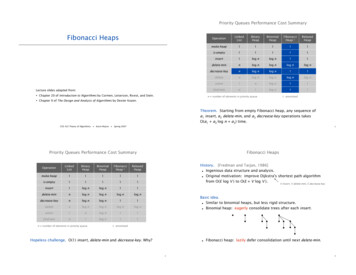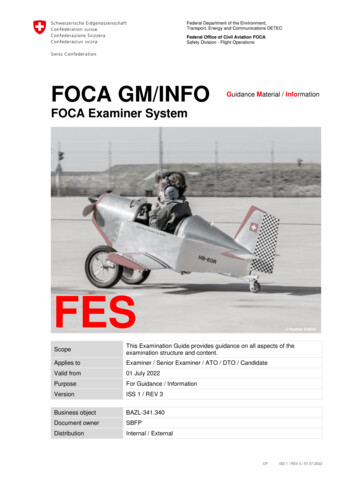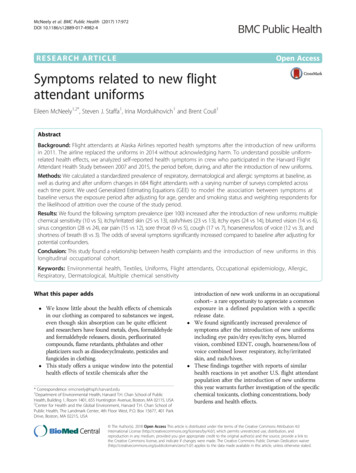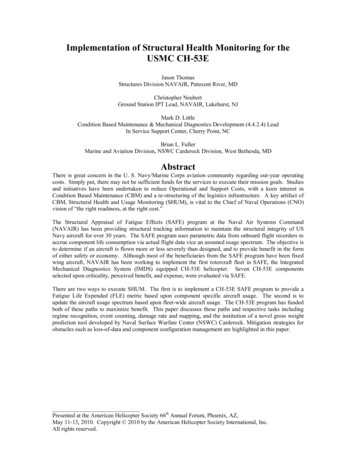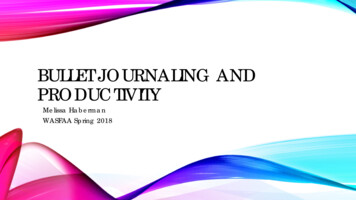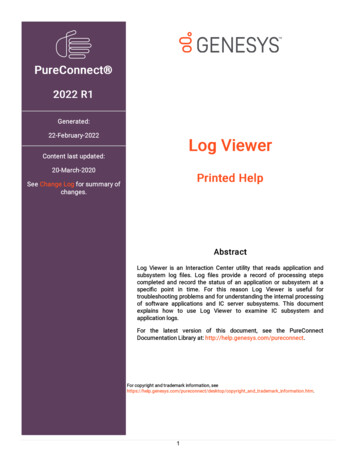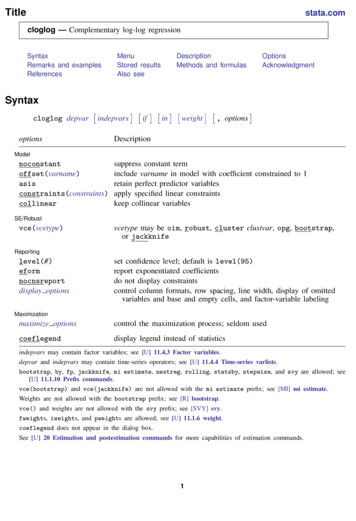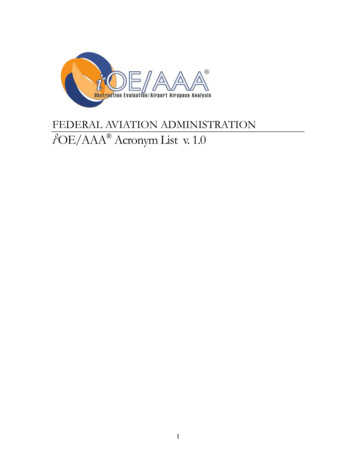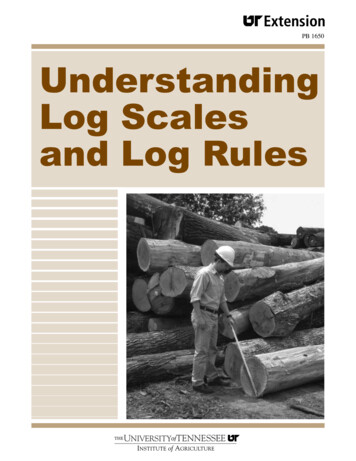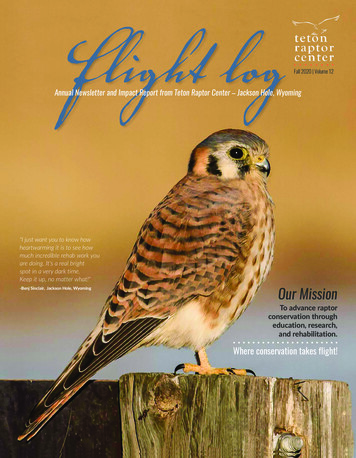
Transcription
Flight logFall 2020 Volume 12Annual Newsletter and Impact Report from Teton Raptor Center – Jackson Hole, Wyoming"I just want you to know howheartwarming it is to see howmuch incredible rehab work youare doing. It's a real brightspot in a very dark time.Keep it up, no matter what!"-Benj Sinclair, Jackson Hole, WyomingOur MissionTo advance raptorconservation througheducation, research,and rehabilitation.Where conservation takes flight!
Board of DirectorsRoger Smith, FounderWayne Turner, ChairSteve Poole, Vice-ChairLisa Friesecke, SecretaryDavid Hoster, TreasurerRich BloomPhoebe CoburnBill EganLeslye HardieChansoo JoungPorgy McClelland, EmeritusHadyn PeeryExecutive Director Amy McCarthy andBoard Chair Wayne Turner at TRC'scampus in Wilson, Wyoming, TRC Staff.Advisory CouncilSteve CainHeather Carleton, D.V.M.Dan Lorimer, D.V.M., DACVOSusan PatlaMark Pokras, D.V.M, EmeritusBert Raynes, EmeritusAndrew SalterJoe Weinman, D.V.M.TRC StaffBryan Bedrosian, Jon Constabel,Nick Delmolino, Luisa Frankenburg,Joy Hart, Amy McCarthy, Lauren McClees,Kevin Patno, Amanda Penn, Sarah Pruden,Kelsey Roberts, Jess Schonegg,Allison Swan, Jessie WaltersMailing/Physical AddressTeton Raptor CenterP.O. Box 1805, Wilson, WY 830145450 W. Hwy. 22, Wilson, WY 83014Contact onraptorcenter.orgConnect With Us:Cover photo: American Kestrel in the wild, Chuck Schneebeck Photography.Letter from the Executive Director and Board Chair“It is not the strongest of the species that survives, not the most intelligent that survives.it is the one that is the most adaptable to change.”― Charles DarwinLast year, as we sat to pen our annual letter to you, we looked toward 2020 withenthusiastic and ambitious vision. Our sights focused on advancing raptor conservationthrough innovative approaches to education, research, and rehabilitation, the three pillars of Teton Raptor Center’s mission. We also looked forward to a year of significant siteimprovements —all focused on bird care— that would create a new and expanded clinic,upgraded chambers for our resident raptors, and a flight barn.In spite of the many challenges 2020 has brought, and because of your continuedsupport and enthusiasm for our work, we are proud of what we accomplished this pastyear. Among these, opening the doors to new state-of-the-art facilities to care for raptorpatients and ambassadors. Extraordinary in its own right, but even more so during thisunprecedented year.Today, however, as we reflect on this past year, the key word to describe 2020 isnot vision, but rather adaptation. As we close out a year filled with some of the greatestvolatility and uncertainty in generations, we are pleased to share that Teton Raptor Centerhas drawn on our most needed and treasured qualities to ensure uninterrupted service toinjured, ill, and orphaned raptors; sustain ongoing studies in the field to better understandraptors and their needs; and bring new and creative approaches to educational outreach.Each day since the pandemic hit, Teton Raptor Center’s team has showcased passion,resiliency, creativity, and adaptability.Birds teach us about adaptability and resiliency each and every day. As we close outa year that won’t soon be forgotten, we ask you to remember the birds. Please considerentering the new year as one of our “Frequent Flyers” — a recurring donor — and haveyour gift matched through this year’s Flight Challenge.Be well. Stay safe. Go birding!With great gratitude for your commitment to this cause,Injured Raptor Hotline307.203.25512Ext. 1 Available DailyAmy Brennan McCarthyExecutive DirectorWayne TurnerBoard Chair
Become a Frequent FlyerHave your gift matched during the 2020 Year-EndGiving ChallengeRaptor conservation needs sustaining members to help raptors keepflying. You can become a Teton Raptor Center Frequent Flyer with arecurring gift that will ensure we are able to provide engaging educationprograms, innovative research and have the latest tools and training torehabilitate injured and ill raptors. The Frequent Flyer program is a groupof dedicated supporters who are helping us advance raptor conservationby giving on a monthly basis.Help us soar out of 2020 and into 2021 with a donation between nowand December 31, 2020! All new supporters who enroll in the FrequentFlyer program and donors who make a new or upgraded gift, will have theirgift matched through the generous year-end Flight Challenge sponsored bythe John M. Simpson Foundation and David May.To sign-up for our monthly giving program or make a gift online pleasevisit www.tetonraptorcenter.org. You may also call us at 307-203-2551 tobecome a TRC Frequent Flyer.A gift of 10 per month willsupply our resident raptors withtheir annual supply of Vitahawk(a vitamin supplement).Invest in Raptor ConservationA gift of any size ensures that our education, research,and rehabilitation programs continue to soar.Recurring Gifts: NEW! Become a Frequent Flyer byproviding a monthly donation through our website,tetonraptorcenter.org.Donate Online, By Mail, or By Telephone: Making agift is as simple as writing a check payable to TetonRaptor Center or authorizing a charge from your creditor debit card via our website, using the enclosedenvelope, or contacting us at 307.203.2551.Matching Gifts: Many companies match gifts madeby employees to nonprofit organizations. Increasethe impact of your gift by asking your employer tomatch your contributions to TRC.Planned Gifts: Leave a legacy for raptor conservationby joining The Soaring Society and naming TRC inyour will or estate plans.Gift of Securities: Gifts of stocks, bonds, andmutual funds are a great way to support our work.Contact TRC for information on gifting securities.Facebook: Comment “#donate ” on ourFacebook page and you’ll quickly make a differencefor birds of prey through GoodWorld.AmazonSmile: Amazon will donate 0.5% of yourpurchase to raptor conservation when you shop atsmile.amazon.com and select Teton Raptor Centeras the charitable organization.“We chose to be monthly donorsto Teton Raptor Center because webelieve they are doing some of the mostimportant work in this valley. Every timewe see an eagle, an osprey, a hawk, orhear an owl in the evening's darkness,we feel peace and yet are remindedof the bigger issues that need to beaddressed to help save this planet.”— Jennifer Durning, Wilson, Wyoming, TRCFrequent FlyerPlease contact us to learn more about ways tocontribute to raptor conservation, 307.203.2551.Teton Raptor Center is a 501(c)(3)nonprofit organization. Donationsare tax-deductible.Our tax ID # is 83-0328068.Red-tailed Hawk, Steve Poole.tetonraptorcenter.org raptors@tetonraptorcenter.org 307.203.25513
Story of the Year30-Year-Old Bald EagleWindow Strike RecoveryAfter a six-week recovery at TRC's RehabilitationClinic, this eagle was released back into the wild.On January 28th, a local resident of Jackson WY, ReedMoulton, had an unlikely visitor crash through his double-panedwindow and land in his bedroom. This fully mature Bald Eaglecrashed through the window and was unconscious for about10 minutes, which gave Reed enough time to call WyomingGame and Fish who referred him to Teton Raptor Center. TetonRaptor Center staff member Meghan Warren and volunteerAnne Hare were on the scene shortly and were able to safelyMinutes after the eagle crashed through adouble-paned window, Reed Moulton.4BAEA 1.28.20 released back intothe wild, Mark Gocke.retrieve the bird from Reed’s bedroom, although it put up a goodfight and sent glass shards everywhere. While it is a commonoccurrence for birds to crash into windows, it’s not often tohear of a Bald Eagle hitting one. Once the bird was in hand,Anne quickly noticed that the bird had bands on both of its legsand the identification number was reported to the USGS BirdBanding Lab. At first an error message occured, meaning eitherthe number was entered incorrectly or the eagle was unusuallyold. The eagle turned out to be 30 years old and was banded inthe Greater Yellowstone Ecosystem in the spring of 1989! Staffand volunteers alike were astonished to discover this Bald Eaglewas one of the oldest eagles ever to be documented in the wild.The Bald Eagle was admitted that same day and was giventhe identification code: BAEA 1.28.20, (an abbreviation for hisspecies, plus his date of admission). After a thorough examination,TRC’s rehabilitation team treated the eagle for lacerations to thefeet, wings, and right eye, and for an elevated lead level in thebird’s blood. Each year, eagles feed on gut piles that are litteredtetonraptorcenter.org raptors@tetonraptorcenter.org 307.203.2551
with tiny fragments from lead bullets that can result in lead poisoning.This elevated lead level most likely was a contributing factor to the birdcrashing through the window. Treatment consisted of anti-inflammatorymedications, wound care for the many lacerations, and two rounds ofchelation therapy to pull the lead out of the bird’s blood. While at TRC,the eagle soon became very aggressive and feisty. Dr. Lorimer, an avianophthalmologist on TRC’s Advisory Council, was able to examine the righteye before release to ensure the cut had fully healed. After a month and ahalf of care, the lacerations healed and the bird’s lead level was low withno symptoms. On March 6th, 2020, BAEA 1.28.20 spread his wings andreturned to the wild once again.BAEA 1.28.20 rescued and preparingfor transport to TRC’s clinic, TRCVolunteer.14 raptors were admittedduring the 19-20 fiscal yearafter crashing into windows,seven of which were able tobe released back into the wild.TRC's 1000th patient! TRC Staff.Our 1,000th PatientOn May 10, 2020 Teton Raptor Center admittedits 1000th patient to the rehabilitation clinic.An American Kestrel was unfortunately struckby a vehicle in Rexburg, ID and sustained aluxation of the ulna and radius in the elbowof the right wing. Thankfully the talentedveterinarians at Jackson Animal Hospital wereable to set the bones back in place the very nextday. Unfortunately, this patient was ultimatelyeuthanized as it was not able to fully recoverfrom the trauma due to the car strike.Bald Eagle 1.28.20 receiving treatment from TRC staff memberJess Schonegg and volunteer Bill Finerty. TRC Staff.5
Year in ReviewImpact ReportFinance: Teton Raptor Center’s fiscal year runs from June 1st through May 31st. TRC generated 934,294 in revenue,with an additional 1,659,467 in restricted funds to support TRC’s capital improvements. Total FY 2019-20 operationalexpenses were 969,340. TRC’s Form 990 is posted on our website and we invite you to review that report for moredetailed financial information. Our FY 2020-21 operational budget is 986,034. The statistics reported throughout thispublication focus on the fiscal year, June 1, 2019 - May 31, 2020.Fundraising Efficiency:In FY 2019-20, TRC spent 2 cents to raise each donated dollar (or 2 spent to raise 100). Both Charity Watch and BBB Giving Alliance guidelines state that it should cost no more than 35 to raise 100worth of funds.Income by SourceExpenses by ClassFunctional ExpensesOperating RevenueProgram ServiceRevenue32%Fundraising4%Sales &InvestmentIncome1%Management9%Contributions& Grants67%Program87%Program ParticipantsVolunteer HoursBy Fiscal YearBy Fiscal 9tetonraptorcenter.org raptors@tetonraptorcenter.org 2019/20
By the Numbers: FY 2019-2020401Educationalprograms delivered124Raptorpatients14Ongoing research andconservation projects49,615Programparticipants1,641Poo-Poo Projectscreens distributed99Raptor RescueNetwork volunteers7,341Volunteer hoursdonated135,000 Most PopularSocial Media PostThis 30-year-old bald eagle crashed through a doublepaned window into a bedroom in Jackson. Age wasdetermined by USGS leg bands from when the bird wasadmitted to our clinic. The eagle was successfully releasedback into the wild on March 6, 2020. This post reachedover 135,000 people on social media.The eye of a 30-year-old Bald Eagle admitted withsoft tissue damage and lacerations after strikingand flying through a window, @TRC Staff.tetonraptorcenter.org raptors@tetonraptorcenter.org 307.203.25517
EducationVolunteers and staff engage with Flights and Feathers programparticipants at the Jackson Hole Airport, TRC Staff.The Year of Adaptation2020 has provided us with both challenges and opportunities to adapt to an ever-changing world. The education team at TRChas worked tirelessly to adapt to the changing educational landscape, exhibiting a great showcase of ingenuity and creativity in theways that we can engage our program participants. As social distancing and personal safety remain a priority, we continue to adaptour educational offerings to best fit the needs of our audience, and our staff, by offering an array of safe and fun ways that you caninteract with TRC’s educational ambassadors, and learn a thing or two along the way!An Incredible TeamTRC’s Education Team By The NumbersJune 1, 2019 - May 31, 202014 Avian Ambassadors325 Programs featured Hunter the Peregrine Falcon401 Education programs this fiscal year1,921 Hours donated by the education team volunteers7,824 Miles traveled by our education team49,615 Program participants8tetonraptorcenter.org raptors@tetonraptorcenter.org 307.203.2551TRC volunteer Ben Prochnow with Otusthe Eastern Screech Owl, TRC Staff.
mf.Spotlight: AmeriCorps at TRCAmeriCorps service members have played a vital rolein TRC’s education team for many years. This year, as with manythings, COVID-19 caused their service to look a bit different.Our AmeriCorps members served virtually this year, meeting via video platforms andworking on projects from their own homes. These AmeriCorps opportunities are madepossible through partnership with Teton Science Schools.Mary Sellars - AmeriCorps Member 2020Mary Sellars completed her undergraduate degree in WildlifeBiology and Geographic Information Systems from NorthlandCollege in Ashland, Wisconsin on the shores of Lake Superior.While studying in Wisconsin’s Northwoods she manageda research project examining the breeding habitat of theAmerican Kestrel and prescribed fires as a source of ecologicalMary handles Beatrix, TRC’srestoration for wildlife. This experience illustrated first hand theresident American Kestrel, TRC Staff.significance of raptors as an indicator species for ecosystemhealth. Mary pursued an AmeriCorps position with Teton Science Schools to serve at theintersections of wildlife science and community organization in the Greater YellowstoneEcosystem. Mary chose to work with the Teton Raptor Center as part of her AmeriCorpsservice term because she believes the intersections of research, education and wildliferehabilitation are fundamental to species and ecosystem recovery.Finley Tevlin - AmeriCorps Member 2020Finley’s time as an AmeriCorps member and educationintern with Teton Raptor Center challenged and pushedhim to master new skills, develop new ideas and ways ofhandling tasks, and allowed for growth opportunities, bothpersonally and professionally. Finley shared, “This time hasbeen of irreplaceable value, allowing me to become part ofa team that feels more like family. After my experience asFinley Tevlin, TRC Staff.an AmeriCorps member and education intern with TetonRaptor Center, I would encourage anyone who has considered this kind of service togive it a try, and see what amazing things you too can accomplish!"Eli Wilson - AmeriCorps Member 2020Eli grew up in Rhode Island, where he spent his summers onthe Atlantic Ocean and his winters in the White Mountains.Along the way, Eli cultivated a deep appreciation for naturalbeauty and all of its organisms—especially birds! Eli hopes tocontinue expanding his curiosity through schooling, handson work, and activities in his free time. Eli recently graduatedfrom Georgetown University, where he studied ecologyEli Wilson, Eli Wilson.and physics, and had the opportunity to participate in somecool field research and teaching experiences along the way. Eli came to Teton RaptorCenter through the AmeriCorps program at Teton Science Schools, drawn by TRC’sunique combination of research, rehabilitation, and education, and their friendly team ofemployees and volunteers.TRC Owls Enhance Virtual MeetingsThroughout the pandemic Teton RaptorCenter has been working with virtualmeeting participants to “Give a Hoot” byhaving TRC resident raptors drop intomeetings for fun learning experiences.These educational “Zoom bombs”have been a great way to break up themonotony of virtual meeting experiencesand introduce attendees to the incredibleadaptations of owl species.“This time has been ofirreplaceable value, allowingme to become part of a teamthat feels more like family.”- Finley Tevlin, AmeriCorps MemberEducation Wish ListYour Donation Can Help the Birds! 25,000BIG WISH Sponsor an AmeriCorps 10,000Education program underwritingmember or education intern 2,500Education materials (supplies,posters, print materials, etc.) 1,500Gas (7,824 miles traveled inFY19/20) 1,000Equipment (perching, leashes,kennels, etc.) 500Staff/Ambassador Uniforms 100Art suppliesVisit our website for our ongoing andup-to-date wish list items.9
ResearchKatherine Gura, TRC Staff.Sarah Ramirez, TRC Staff.Creating OpportunityTRC facilitates graduate level projects for past,current, and future researchersBeyond advancing wildlife science, management, andtechnology, our research department is continuing a stronghistory of helping to foster the next generation of wildlifebiologists. Equally important to understanding and gatheringcritical data to manage raptors, our research also serves as acatalyst for learning and opportunity with young scientists. Weare proud to help facilitate many graduate level projects forpast, current, and future researchers at Teton Raptor Center.Six years ago, we bolstered our research program and solidifiedTRC’s three-pillar approach to raptor conservation with foci oneducation, rehabilitation, and research. In line with these goals,several biologists from our research team have used our researchprojects to obtain Master’s and PhD degrees.Recently, Beth Mendelsohn used data she helped collectwhile at Teton Raptor Center to complete her Master’s projectinvestigating the genetic connectivity of Great Gray Owls inwestern North America at the University of Wyoming (UWYO).Two other TRC employees are currently pursuing advanceddegrees at UWYO. Katherine Gura has been collecting vitalmovement data on Great Gray Owls to map critical habitats ofthis secretive raptor for her PhD. Nathan Hough is using data heNathan Hough, TRC Staff.Beth Mendelsohn, TRC Staff.helped collect while at TRC to map critical habitats of GoldenEagles in Wyoming and beyond. Similarly, after working bothin our rehabilitation and research departments, Sarah Ramirezis currently working on her Master’s degree at Colorado StateUniversity using our research project on how best to mitigatedevelopment effects on Ferruginous Hawks.In addition to our research team using our projects forgraduate school, we also provide valuable data for many graduateprojects not directly associated with Teton Raptor Center. Datafrom our projects are helping graduate students model habitatsof Rough-legged Hawks in western North America, describe thegenomics for Golden Eagles, and link geophagy (soil ingestion)and habitat use for Greater Sage-grouse.Researching and providing data to manage our raptors isn’tenough to conserve wildlife in the long-term. Equally importantis helping to educate and train future biologists. We are proudto be able to provide those opportunities through our ongoinglong-term research at Teton Raptor Center.“An investment in knowledgepays the best interest.”-Benjamin FranklinIt costs roughly 35,000 a yearto support a graduate studenton top of normal project costs.TRC research staff member, Allison Swan, TRC Staff.10
TRC Research Director, Bryan Bedrosianwith a Short-eared Owl during fieldresearch, TRC Staff.Research Wish ListYour Donation Can Help the Birds! 15,000Conservation CollaborationIt takes a village. Conserving raptors is no exception. When a species relies ondifferent habitats across a continent, collaboration is key. We have been workingfor years with different teams of researchers to map critical habitats of Roughlegged Hawks and Golden Eagles. This year, we embarked on a new adventurewith dozens of others to learn more about a grassland raptor, the Short-earedOwl. As part of a national initiative lead by the Intermountain Bird Observatory inBoise, Idaho, we are collectively trying to gather data from at least seven statesto learn about this nomadic species. This owl nests on the ground across thesagebrush sea in Wyoming and we are leading the efforts here to gather criticaldata to help these owls. Last spring, we were able to kick off this study for theteam by marking the first two owls ever in the state.BIG WISH 6 GPS transmitters forNorthern Goshawk study 7,500All-terrain vehicle with trailer 2,250Acoustic recorders 1,750DSLR Still/4K video camera kit 1,000In-Reach satellite safety devicewith subscription 750Software subscriptions (ArcGIS,Adobe, Acoustic Analysis) 300Mud/snow truck traction ramps 200Two professional first-aid kits 150GoPro gimbal stabilizer 50Fuel cards (many needed)Unlocking SecretsIt is amazing how a huge raptor canvanish in a flash though the dense forest.As one of the few sensitive raptors in theWest, the Northern Goshawk is our largestAccipiter, or forest hawk. Known by theirgray feathers and unmistakable crimsoneye, goshawks have short, rounded wingsand long, rudder-like tails allowing themto zip through tight forests. Eerily silentduring the nesting season, they switchto aggressively protect their young, evenhitting people in the head as they walk by.We still don’t know much about thisspecies in Wyoming. How many are there?Are populations stable? Do they migrate?What do they eat? How much area do weneed to protect? These are among someof the questions we just set out to answer.In 2020, we began outfitting goshawkswith GPS transmitters to unlock some oftheir secrets.Northern Goshawk outfitted with transmitter, TRC Staff.tetonraptorcenter.org raptors@tetonraptorcenter.org 307.203.255111
RehabilitationRaptor Rescue Network during COVID-19“Being a Raptor Rescue Network volunteer is a most fulfilling role to play, as we transportthese magnificent injured and rehabilitated birds in their critical time of need.”-Denny Emory, Raptor Rescue Network VolunteerWhile the COVID-19 pandemic has forced us to modify ourapproach to bird care, especially with greatly reduced volunteerparticipation, Teton Raptor Center has not turned away anybirds in need of our care throughout this health crisis. One wayvolunteers have sustained engagement is through our RaptorRescue Network (RRN), providing a safe and socially distantvolunteer opportunity by helping to transport injured, ill, andorphaned birds from throughout Wyoming and Idaho to care atTeton Raptor Center’s clinic. TRC (and the birds) are honored tohave such dedicated volunteers during these uncertain times. TheRaptor Rescue Network was created to coordinate the effortsof the four raptor rehabilitation resources for Wyoming, agencypartners, veterinarians, and transport volunteers to ensure thatevery injured raptor has access to the care it needs. Recently, wereceived a grant through the National Fish and Wildlife Foundationto help enhance the RRN and provide better, and more efficientcare to injured raptors. Please contact us if you are interested inbecoming a member of our Raptor Rescue Network.RRN Volunteer Denny Emory transporting aninjured Great Horned Owl, TRC Staff.For the FY 19-20, our RaptorRescue Network volunteersdonated over 100 hours ofdrive time and 5,700 miles!Luisa Frankenburg, Rehabilitation Assistant, withGolden Eagle patient, TRC Staff.1212Bald Eagle receiving an eye exam by Dr. Lorimerbefore release, TRC Staff.tetonraptorcenter.org raptors@tetonraptorcenter.org 307.203.2551
Rehab Statistics June 1, 2019 - May 31, 2020124 Raptor Patients*33 Birds released back to the wild56% Survival Rate for birds surviving more than 24 hours23 Great Horned Owls admitted — our most common species18 patients from Idaho Falls & 18 from Jackson Hole23 Admissions in July and September— our busiest monthsAdmissionsby Species21 Distinct raptor species admitted128632423211American KestrelBald EagleBarn OwlCooper's HawkFlammulated OwlGolden EagleGreat Horned OwlLong-eared OwlMerlinNorthern Goshawk2182215291182*TRC also supplied emergency triage and stabilization to 23non-raptors, covering 9 different species of songbirds and corvids.Northern Pygmy-OwlNorthern Saw-whet OwlOspreyPeregrine FalconPrairie FalconRed-tailed HawkRough-legged HawkSharp-shinned HawkShort-eared OwlSwainson's HawkTurkey VultureBarn Owl ready forrelease, TRC Staff.CASE STUDY- Barn Owl CarStrike VictimOn the evening of February 8th, a member of thepublic witnessed a Barn Owl hit by a car whileit was hunting. The bird was showing signs of aconcussion so they called Teton Raptor Center’sRaptor Hotline and the bird was admitted as apatient. X-rays luckily showed no broken bonesfrom the car strike, but the bird was sufferingfrom head trauma and ulcers, or infected cuts, inboth eyes. Treatment included eye drops and antiinflammatory medications, along with time in ouroxygen chamber to help alleviate its concussion.Luckily the bird made a quick recovery after onlytwo weeks and was released back into the wild bythe Idaho Department of Fish and Game.Cost of Rehabilitation: 384 16 hours of volunteer supportRehab Wish ListYour Donation Can Help the Birds! 48,000 3,000Send our rehabilitators to a rehabilitationmedical conference 1,500Medical supplies for 6 months 750Supplies to conduct in-house bloodwork 500Fund a bird’s surgery 500iPad for new Rehab Clinic 350Purchase Abaxis Rotors to help analyzepatient bloodwork 50TRC rehabilitation crew, TRC Staff.BIG WISH Portable DRE X-ray Machine & TableMedical books and subscriptions13
Poo-Poo ProjectThe 16,000th Poo-Pooscreen went to SalmonChallis National Forestin Idaho.California State Parks staff installing Poo-Poo screens atSVRA, Hungry Valley, CA State Parks.Poo-Poo Project Continues to ExpandOur long-time partner and screen manufacturer, Premier PowderCoating and Custom Fabrication, purchased a new laser cuttingmachine in 2019. This advanced technology allowed TRC tosave costs on welding labor and powder coating and providean improved stainless steel product for our partners at 34.50.These stainless steel Poo-Poo Screens have been in circulationfor a year and the reviews are in; they are easier to install andbetter at withstanding various weather conditions! If you are inneed of custom sized Poo-Poo Screens, we have them availablefrom 39.95 and bulk orders of 75 screens for 2,495. Withour reliable Poo-Poo Screens 2.0 and a price reduction, we arewell on our way to completely screening all state parks acrossthe country.14Barn Owl rescued from a vault toilet, USFStetonraptorcenter.org raptors@tetonraptorcenter.org 307.203.2551
ts.States with the mostPoo-Poo Partners:Map of all Poo-Poo Partners, TRC on34Sponsor-a-ScreenThe Sponsor-a-Screen program is crucial to protecting cavity-nesting wildlife.Just 45 allows individuals and families to participate in wildlife conservation andhelp raise awareness about wildlife entrapment issues. The program began in thesummer of 2016 and over 2,300 sponsored screens have been purchased by TRCsupporters and shipped to Poo-Poo partners around the United States and beyond.With the holidays approaching, are you wondering what to get that person whohas everything, or is just hard to buy for? Sponsor-a-Screen as a gift to celebrate afamily member or a friend, and TRC will send you a sticker and a special Poo-Poogreeting card that you can personalize and mail directly to the recipient. Plus, youwill find out when and where your sponsored Poo-Poo Screen is installed.Poo-Poo Project HistoryEvery year, thousands of cavitynesting birds and mammals becomeentrapped in vertical pipes, such asventilation pipes. Vault toilets foundin many of American’s wild areas,feature a 12-inch diameter ventilationpipe that mimics the natural cavitiespreferred by various bird species.Once a bird enters the ventilationpipe, it can easily become entrappedand often succumbs to starvation,dehydration, or disease. TRC beganworking with federal, regional, andstate agencies in 2010 to screen vaulttoilet ventilation pipes. Our affordablescreens are durable, easy to install,and provide superior ventilation.250 Hours donated byPoo-Poo volunteerslast yearProject PartnersPoo-Poo HeroesCarol Poole, a dedicated Poo-Poo Projectvolunteer, has been a huge asset to the projectas she continues to donate personal time toprepare Poo-Poo Screen orders for shipment. Everdedicated through these uncertain times, she isable to ensure that every order of Poo-Poo Screensis ready to protect cavity-nesting wildlife.June Green is based in Missouri and remains asteady figure in the Poo-Poo Project. She is anessential and enthusiastic ambassador for theproject, donating hundreds of hours every yearto ensure there is awareness of the danger posedby unscreened vault toilet ventilation pipes to allfederal and state agencies.Boreal Owl in basement ofvault toilet, USFS.Carol Poole packaging Poo-Pooscreen orders at TRC, TRC Staff.Assoc. of Nature Center AdministratorsAudubon Society ChaptersState Park AgenciesState Wildlife AgenciesNational Park ServiceNumerous County AgenciesUS Army Corps of EngineersUS Bureau of Land ManagementUS Fish and Wildlife ServiceUS Forest ServiceThe Natur
Teton Raptor Center is a 501(c)(3) nonprofit organization. Donations are tax-deductible. Our tax ID # is 83-0328068. "We chose to be monthly donors to Teton Raptor Center because we believe they are doing some of the most important work in this valley. Every time we see an eagle, an osprey, a hawk, or hear an owl in the evening's darkness,
